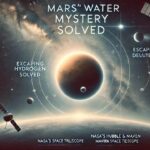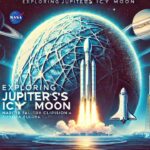NASA Lucy spacecraft, Asteroid Selam, cosmic toddler, space exploration, Jupiter Trojan asteroids, main asteroid belt, solar system formation, celestial bodies, young asteroids, planet formation theories
“Dive into the fascinating discovery of Asteroid Selam by NASA’s Lucy spacecraft. Dubbed a ‘cosmic toddler,’ Selam offers unique insights into the early stages of the solar system. Explore how this young asteroid’s characteristics and orbit can help scientists unlock the mysteries of celestial formation and evolution.”

In the vastness of our solar system, the Lucy spacecraft, launched by NASA, continues to make groundbreaking discoveries. Among its latest observations is the curious asteroid Selam, an intriguing celestial body that scientists are referring to as a “cosmic toddler.” This designation highlights not only Selam’s relatively recent formation in astronomical terms but also its unique characteristics that could provide insights into the early solar system.
The Discovery of Asteroid Selam
Launched in October 2021, NASA’s Lucy spacecraft has the primary mission of exploring Jupiter’s Trojan asteroids—clusters of space rocks that share Jupiter’s orbit around the Sun, thought to be remnants of the early solar system. However, its journey recently brought it into close proximity with Selam, an asteroid in the main asteroid belt located between Mars and Jupiter. This unexpected encounter has provided researchers with a unique opportunity to study a body that has remained largely unchanged since the solar system’s formation.
Selam was detected by Lucy’s high-resolution cameras, which captured detailed images of the asteroid’s surface. The images revealed a rocky, irregular-shaped body with a surface marked by craters and boulders. This physical appearance is typical of young celestial bodies that have not undergone significant geological transformations.
Characteristics of Selam: A Young Space Rock
Asteroid Selam, approximately 4 kilometers in diameter, exhibits features that are characteristic of a young space object. Its surface is covered in a fine regolith, or dust, which is believed to be relatively fresh in astronomical terms. This suggests that Selam has not been subjected to extensive weathering or collisions that typically age and reshape asteroids over billions of years.
The asteroid’s orbit also contributes to its classification as a cosmic toddler. Unlike older asteroids whose orbits might have been altered by gravitational interactions with other planets, Selam’s orbit remains relatively undisturbed, indicating its youthfulness and providing a pristine record of the early solar system’s conditions.
Scientific Significance of Studying Selam
Studying Selam offers valuable insights into the processes that governed the early solar system. By analyzing the asteroid’s composition and surface features, scientists can infer the types of materials that were present during the solar system’s formation. This includes identifying the presence of organic compounds, which are crucial for understanding the origins of life.
Furthermore, Selam’s well-preserved condition makes it an ideal candidate for studying the accretion process—how dust and small particles clumped together to form larger bodies. The data gathered from Selam could help scientists refine their models of planet formation, offering clues about how Earth and other planets came to be.
Lucy’s Mission and Future Targets
Lucy’s encounter with Selam is just one part of its broader mission to explore the Trojans. The spacecraft is slated to visit seven Trojan asteroids between 2027 and 2033. These asteroids are believed to be remnants of the primordial material that formed the outer planets, and studying them could provide further understanding of the solar system’s history and evolution.
Each of these encounters will allow Lucy to gather critical data on the composition, density, and geological history of these ancient bodies, offering unprecedented insights into our cosmic neighborhood.
Conclusion: The Importance of Cosmic Exploration
The discovery and ongoing study of asteroid Selam underscore the importance of space missions like Lucy. By sending spacecraft to distant celestial bodies, we can uncover the hidden chapters of our solar system’s story. These missions not only satiate human curiosity but also equip us with the knowledge to hypothesize about life’s potential beyond Earth.
As Lucy continues its journey through space, each asteroid it encounters will add pieces to the puzzle of our solar system’s mysterious past. The study of Selam, the cosmic toddler, is just the beginning of unraveling these cosmic mysteries, promising a future rich with astronomical discoveries and insights.
- Groundbreaking NASA Study Reveals New Insights into Global River Systems
- NASA Artemis Generation: Cultivating the Moon Trees Across America
- NASA Fermi Reveals the Universe in New E-Book
- NASA Pioneering Airborne Missions: Advancing Earth and Climate Science










